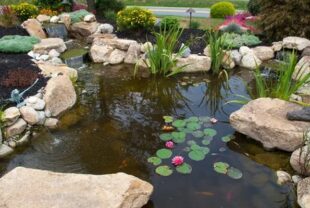 I have built many ponds throughout the years and have a passion for landscaping, I can say with confidence that adding a pond into your outdoor space is a fantastic way to add beauty, relaxation, and a touch of nature to your home. Not only do ponds provide a beautiful visual element, but they can also attract wildlife and provide a space for outdoor recreation and relaxation.
I have built many ponds throughout the years and have a passion for landscaping, I can say with confidence that adding a pond into your outdoor space is a fantastic way to add beauty, relaxation, and a touch of nature to your home. Not only do ponds provide a beautiful visual element, but they can also attract wildlife and provide a space for outdoor recreation and relaxation.
When planning to include a pond into your garden/landscaping design, there are a few key factors to keep in mind.
First of all, it’s important to pick the right location for your pond. See and imagine the size and shape of the area you have available, as well as the amount of sun and shade it will get throughout the day. You’ll also want to think about the surrounding plants and structures, and how the pond will fit in with the entire design of your backyard garden.
Once you’ve done with the location, it’s time to start thinking about the size and shape of your pond. Again, take into account the available space you have and the overall design of your landscaping. A rectangular pond may fit better in a formal garden, while a more natural, free-form shape may be more suitable for a casual, rustic setting, suitable for a country-home perhaps.
It’s also important to consider the function of your pond. It could very well be a tranquil water feature, a home for fish and other aquatic life, or a place for even some swimming and recreation? Your choice of size, shape, and depth will be influenced by the intended use of the pond.
 Another key factor to consider is the materials you’ll use to construct your pond. There are many options available, including ready-formed pond liners, flexible liners, and natural materials like stone or concrete. Simply select a material that will fit in with the overall design of your landscaping and will be durable and long-lasting.
Another key factor to consider is the materials you’ll use to construct your pond. There are many options available, including ready-formed pond liners, flexible liners, and natural materials like stone or concrete. Simply select a material that will fit in with the overall design of your landscaping and will be durable and long-lasting.
Once your pond is built, another thing to consider are the plants and other elements you’ll want to include into the design. Water plants, such as lilies and lotus, can add beauty and oxygenate the water, while marginal plants, like irises and cattails, can provide habitat for wildlife and help to filter the water. You may also want to consider adding decorative elements like waterfalls, fountains, or even a small bridge. Keep in mind that motorized waterfalls or pond pumps are necessary if you wan’t to keep your pond algae-free, good looking and clean.
Adding a pond into your garden is a rewarding and enjoyable venture that can add value to your home and provide a beautiful, peaceful outdoor space for you and your family to enjoy. With careful planning and attention to detail, you can create a gorgeous pond that will be a beloved feature of your home for years to come.
–
More about on how to fit the pond into your landscape design ideas here.
